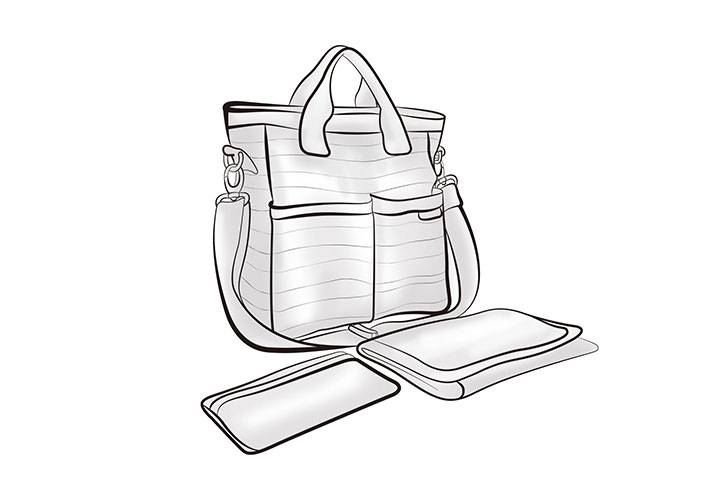Blogs & News
We have a lot of ideas and know-how about bags, material sourcing, sampling, production and a whole host of bag-related topics that we would like to share with you.
Material Matters Choosing the Right Fabrics for Your Bag Collection

In the competitive landscape of fashion accessories, the choice of materials can make or break a bag collection. For Direct-to-Consumer (DTC) brands, where differentiation and customer connection are paramount, selecting the right fabrics is not just a design decision—it’s a strategic one. The fabrics you choose impact everything from the bag’s durability and functionality to its aesthetic appeal and sustainability credentials. As consumers increasingly demand quality, versatility, and eco-friendliness, understanding the nuances of fabric selection has never been more critical.
This article explores the key considerations for choosing fabrics in bag production, delving into the properties of popular materials, emerging sustainable options, and how to align fabric choices with your brand’s identity and target market. Whether you’re launching a new collection or refining an existing one, mastering material selection will elevate your brand and resonate with today’s discerning consumers.
Why Fabric Choice Matters
Fabric selection is the foundation of any successful bag collection. The right material can enhance a bag’s performance, align with your brand’s values, and captivate your audience. Here’s why it’s so crucial:
Durability: Bags are everyday essentials, subject to wear and tear. Fabrics like canvas, nylon, and leather offer varying levels of resilience, influencing the bag’s lifespan and customer satisfaction.
Aesthetics: The look and feel of a fabric define a bag’s style. From the rugged charm of waxed canvas to the sleek sophistication of leather, fabric choice shapes the visual and tactile experience.
Functionality: Different fabrics serve different purposes. Water-resistant nylon is ideal for travel bags, while soft cotton linings enhance comfort in everyday totes.
Cost: Material costs directly affect production expenses and retail pricing. Balancing quality with affordability is key to maintaining profitability without compromising on value.
Sustainability: With eco-conscious consumers on the rise, sustainable fabrics—like recycled polyester or vegan leather—can set your brand apart and appeal to values-driven shoppers.
For DTC brands, where customer relationships are direct and personal, fabric choice also becomes a storytelling tool. It communicates your brand’s commitment to quality, innovation, or sustainability, fostering deeper connections with your audience.

Popular Fabrics in Bag Production: Properties and Use Cases
Understanding the strengths and limitations of common fabrics is essential for making informed decisions. Below are some of the most widely used materials in bag manufacturing, along with their key characteristics:
1. Canvas
Properties: Durable, versatile, and available in various weights. Canvas is typically made from cotton or linen, offering a sturdy yet flexible structure.
Advantages: Breathable, easy to clean, and customizable through dyeing or printing. It’s also relatively affordable.
Drawbacks: Can be prone to water damage unless treated (e.g., waxed canvas).
Best For: Casual totes, backpacks, and everyday carryalls. Brands like Herschel Supply Co. have built their identity around canvas’s rugged appeal.
2. Leather
Properties: Luxurious, durable, and ages beautifully. Full-grain leather is the highest quality, while top-grain and bonded leather offer more affordable options.
Advantages: Timeless aesthetic, exceptional durability, and a premium feel that appeals to luxury markets.
Drawbacks: Higher cost, requires maintenance, and may not align with vegan or eco-conscious values.
Best For: High-end handbags, briefcases, and statement pieces. Brands like Cuyana and Mansur Gavriel exemplify leather’s enduring allure.
3. Nylon
Properties: Lightweight, water-resistant, and highly durable. Often used in technical or performance-focused bags.
Advantages: Excellent for weatherproofing, easy to clean, and available in various textures and finishes.
Drawbacks: Can feel less premium than natural materials and may not biodegrade easily.
Best For: Travel bags, duffels, and sporty designs. Away’s travel accessories showcase nylon’s practicality.
4. Polyester
Properties: Affordable, versatile, and often blended with other fibers for added strength.
Advantages: Resistant to shrinking and wrinkling, quick-drying, and can be recycled into sustainable options.
Drawbacks: Less breathable than natural fibers and may lack a luxury feel.
Best For: Budget-friendly collections, linings, or as a base for sustainable fabrics like recycled polyester.
These fabrics represent just a fraction of the options available, but they form the backbone of many successful bag collections. The key is to match the material’s properties with the intended use and aesthetic of your designs.
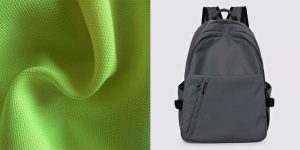
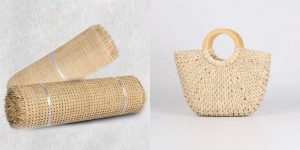
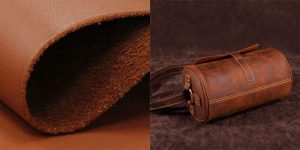
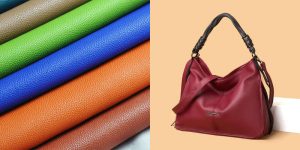
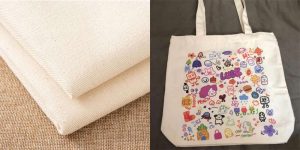
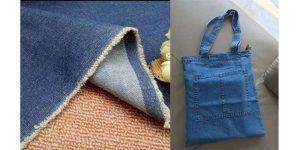
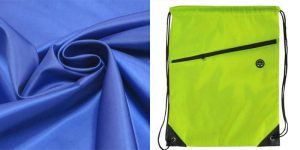
Emerging Trends: Sustainable and Innovative Fabrics
As sustainability becomes a core concern for consumers and brands alike, innovative materials are reshaping the landscape of bag production. DTC brands, with their agility and direct customer feedback loops, are well-positioned to lead this charge. Here are some cutting-edge options to consider:
1. Recycled Fabrics
What They Are: Fabrics made from post-consumer waste, such as recycled polyester (rPET) from plastic bottles or recycled nylon from fishing nets.
Benefits: Reduces waste, conserves resources, and appeals to eco-conscious consumers. Brands like Patagonia have pioneered the use of recycled materials in their bags.
Considerations: Ensure the recycling process is certified (e.g., Global Recycled Standard) to validate sustainability claims.
2. Vegan Leather Alternatives
What They Are: Plant-based or synthetic materials that mimic leather’s look and feel without animal products. Examples include apple leather, mushroom mycelium, and Piñatex (made from pineapple leaves).
Benefits: Cruelty-free, often more sustainable than traditional leather, and increasingly durable.
Considerations: Some alternatives may not yet match leather’s longevity, so test for durability in high-wear areas.
3. Bio-Fabrics and Smart Textiles
What They Are: Fabrics engineered for specific properties, such as self-cleaning, temperature-regulating, or antimicrobial finishes.
Benefits: Adds functionality and a high-tech edge to your collection, appealing to consumers seeking innovation.
Considerations: Higher production costs and the need for clear communication about the benefits to justify premium pricing.
Incorporating these materials not only differentiates your brand but also positions it as forward-thinking and responsible—an attractive proposition for today’s consumers.
How to Choose the Right Fabric for Your Collection
Selecting the perfect fabric requires balancing multiple factors. Here’s a step-by-step guide to help you make the best choice for your brand and audience:
1. Define Your Target Market
Who Are They?: Urban professionals may prefer sleek, durable materials like leather or nylon, while eco-conscious shoppers might gravitate toward recycled or plant-based options.
What Do They Value?: Luxury buyers prioritize premium feel and craftsmanship, whereas budget-conscious consumers seek affordability without sacrificing style.
2. Consider the Bag’s Intended Use
Functionality: A gym bag needs moisture-wicking or odor-resistant fabrics, while an evening clutch benefits from luxurious, tactile materials.
Durability: Everyday bags require sturdier fabrics like canvas or leather, while occasional-use pieces can experiment with delicate textiles.
3. Align with Your Brand Identity
Aesthetic: Choose fabrics that reflect your brand’s visual language. A minimalist brand might opt for clean, unembellished materials, while a bohemian label could explore textured or patterned fabrics.
Values: If sustainability is central to your brand, prioritize eco-friendly materials and transparent sourcing.
4. Evaluate Production Capabilities
Manufacturer Expertise: Ensure your manufacturer has experience working with your chosen fabrics, especially if they’re unconventional or require specialized handling.
Cost and Scalability: Balance material costs with production efficiency. Some fabrics may require higher minimum orders or longer lead times, impacting your ability to scale.
5. Test and Iterate
Prototyping: Create samples to test how fabrics perform in real-world conditions. Check for issues like color fading, seam strength, or water resistance.
Customer Feedback: Use direct customer insights to refine your choices. DTC brands have the advantage of gathering feedback quickly and adjusting designs accordingly.
By methodically evaluating these factors, you can select fabrics that not only meet practical needs but also elevate your brand’s narrative and appeal.

Case Studies: Fabric Success Stories
Real-world examples illustrate how strategic fabric choices can drive success:
Everlane: Known for transparency, Everlane uses recycled polyester and organic cotton in its bags, appealing to eco-conscious consumers while maintaining a sleek, modern aesthetic.
Rains: This brand’s use of waterproof polyester has made it a go-to for stylish, weather-resistant bags, proving that functionality can be a key selling point.
Matt & Nat: By exclusively using vegan leather and recycled materials, Matt & Nat has carved out a niche in the sustainable luxury market, showing that ethics and elegance can coexist.
These brands demonstrate that thoughtful fabric selection, aligned with brand values and customer needs, can create a powerful market differentiator.
Conclusion: Fabric as a Strategic Asset
In the world of DTC bag collections, fabric is more than just a material—it’s a strategic asset that influences everything from product performance to brand perception. By choosing fabrics that balance durability, aesthetics, functionality, and sustainability, you can create bags that not only sell but also build lasting connections with your audience.
As you design your next collection, remember that the right fabric can tell your brand’s story, meet your customers’ needs, and set you apart in a crowded market. Stay curious, experiment with new materials, and partner with manufacturers who share your commitment to quality and innovation. The future of your bag collection begins with the fabrics you choose today.

